LG Electronics USA MS770 CELLULAR/AWS/PCS CDMA&AWS;/PCS LTE PHONE w/BT&WLAN; User Manual LG MS770 MPCS QRG EN V1 0 120711
LG Electronics MobileComm USA, Inc. CELLULAR/AWS/PCS CDMA&AWS;/PCS LTE PHONE w/BT&WLAN; LG MS770 MPCS QRG EN V1 0 120711
Contents
- 1. user manual
- 2. Users Manual final
Users Manual final

1
Important Customer Information
WARNING: This product contains
chemicals known to the State of
California to cause cancer and birth
defects or other reproductive harm.
Wash hands after handling.
When using this product, the safety
precautions below must be taken
to avoid possible legal liabilities and
damages.
Retain and follow all product safety
and operating instructions. Observe
all warnings in the product operating
instructions. To reduce the risk of
bodily injury, electric shock, fire, and
damage to the equipment, observe the
following precautions.
ELECTRICAL SAFETY
This product is intended for use
when supplied with power from the
designated battery or power supply
unit. Other usage may be dangerous
and will invalidate any approval given
to this product.

2Important Customer Information
SAFETY PRECAUTIONS
FOR PROPER GROUNDING
INSTALLATION
CAUTION: Connecting to improperly
grounded equipment can result in an
electric shock to your device. This
product is equipped with a USB cable
for connecting to a desktop or notebook
computer. Be sure your computer is
properly grounded (earthed) before
connecting this product to the computer.
The power supply cord of a desktop or
notebook computer has an equipment-
grounding conductor and a grounding
plug. The plug must be plugged into
an appropriate outlet which is properly
installed and grounded in accordance
with all local codes and ordinances.
SAFETY PRECAUTIONS FOR
POWER SUPPLY UNIT
Use the correct external power
source
A product should be operated only from
the type of power source indicated on
the electrical ratings label. If you are
not sure of the type of power source

3
Important Customer Information
required, consult your authorized service
provider or local power company. For
a product that operates from battery
power or other sources, refer to the
operating instructions that are included
with the product.
Handle battery packs carefully
This product contains a Li-ion battery.
There is a risk of fire and burns if the
battery pack is handled improperly.
Do not attempt to open or service the
battery pack. Do not disassemble,
crush, puncture, short external contacts
or circuits, dispose of in fire or water, or
expose a battery pack to temperatures
higher than 60°C (140°F).
WARNING: Danger of explosion
if battery is incorrectly replaced.
To reduce risk of fire or burns, do
not disassemble, crush, puncture,
short external contacts, expose to
temperature above 60°C (140°F), or
dispose of in fire or water. Replace
only with specified batteries. Recycle
or dispose of used batteries according
to the local regulations or reference

4Important Customer Information
guide supplied with your product.
Take extra precautions
O Keep the battery or device dry and
away from water or any liquid as it
may cause a short circuit.
O
Keep metal objects away so they
don’t come in contact with the battery
or its connectors as it may lead to
short circuit during operation.
O The phone should be only connected
to products that bear the USB-IF
logo or have completed the USB-IF
compliance program.
O Do not use a battery that appears
damaged, deformed, or discolored,
or one that has any rust on its casing,
overheats, or emits a foul odor.
O Always keep the battery out of the
reach of babies and small children,
to avoid swallowing of the battery.
Consult a doctor immediately if the
battery is swallowed.
O Only use the battery with a charging
system that has been qualified with
the system per this standard, IEEE-
Std-1725-200x. Use of an unqualified
battery or charger may present a risk

5
Important Customer Information
of fire, explosion, leakage or other
hazard.
O Replace the battery only with another
battery that has been qualified with
the system per this standard, IEEE-
Std-1725-200x. Use of an unqualified
battery may present a risk of fire,
explosion, leakage or other hazard.
O Avoid dropping the phone or battery.
If the phone or battery is dropped,
especially on a hard surface, and the
user suspects damage, take it to a
service center for inspection.
O If the battery leaks:
Do not allow the leaking fluid to
come in contact with skin or clothing.
If contact occurs, flush the affected
area immediately with clean water
and seek medical advice.
Do not allow the leaking fluid to
come in contact with eyes. If contact
occurs, DO NOT rub; rinse with clean
water immediately and seek medical
advice.
Take extra precautions to keep
a leaking battery away from fire
as there is a danger of ignition or
explosion.

6Important Customer Information
SAFETY PRECAUTIONS FOR
DIRECT SUNLIGHT
Keep this product away from excessive
moisture and extreme temperatures.
Do not leave the product or its battery
inside a vehicle or in places where the
temperature may exceed 140°F (60°C),
such as on a car dashboard, window
sill, or behind glass that is exposed
to direct sunlight or strong ultraviolet
light for extended periods of time. This
may damage the product, overheat the
battery, or pose a risk to the vehicle.
PREVENTION OF HEARING LOSS
CAUTION: Permanent hearing loss
may occur if earphones or headphones
are used at high volume for prolonged
periods of time.
SAFETY IN AIRCRAFT
Due to the possible interference caused
by this product to an aircraft’s navigation
system and its communications
network, using this device’s phone
function on board an airplane is
against the law in most countries. If

7
Important Customer Information
you want to use this device when its
use is restricted on board an aircraft,
remember to switch to Airplane Mode
which turns off RF functions that could
cause interference.
ENVIRONMENT RESTRICTIONS
Do not use this product in gas stations,
fuel depots, chemical plants or where
blasting operations are in progress, or
in potentially explosive atmospheres
such as fueling areas, fuel storehouses,
below deck on boats, chemical plants,
fuel or chemical transfer or storage
facilities, and areas where the air
contains chemicals or particles, such as
grain, dust, or metal powders. Please be
aware that sparks in such areas could
cause an explosion or fire resulting in
bodily injury or even death.
EXPLOSIVE ATMOSPHERES
When in any area with a potentially
explosive atmosphere or where
flammable materials exist, the product
should be turned off and the user
should obey all signs and instructions.
Sparks in such areas could cause an

8Important Customer Information
explosion or fire resulting in bodily
injury or even death. Users are advised
not to use the equipment at refueling
points such as service or gas stations,
and are reminded of the need to
observe restrictions on the use of radio
equipment in fuel depots, chemical
plants, or where blasting operations
are in progress. Areas with a potentially
explosive atmosphere are often, but not
always, clearly marked. These include
fueling areas, below deck on boats, fuel
or chemical transfer or storage facilities,
and areas where the air contains
chemicals or particles, such as grain,
dust, or metal powders.
ROAD SAFETY
Vehicle drivers in motion are not
permitted to use communication
services with handheld devices, except
in the case of emergency. In some
countries, using hands-free devices as
an alternative is allowed.

9
Important Customer Information
SAFETY PRECAUTIONS FOR RF
EXPOSURE
O Avoid using your phone near metal
structures (for example, the steel
frame of a building).
O Avoid using your phone near strong
electromagnetic sources, such as
microwave ovens, sound speakers,
TV and radio.
O Use only original manufacturer-
approved accessories, or accessories
that do not contain any metal.
O Use of non-original manufacturer-
approved accessories may violate
your local RF exposure guidelines
and should be avoided.
INTERFERENCE WITH MEDICAL
EQUIPMENT FUNCTIONS
This product may cause medical
equipment to malfunction. The use
of this device is prohibited in most
hospitals and medical clinics.
If you use any personal medical
device(s), consult the manufacturer
of your device(s) to determine if the
device(s) are adequately shielded from

10 Important Customer Information
external RF energy. Your physician
may be able to assist you in obtaining
this information. Turn your phone
OFF in health care facilities when
any regulations posted in these areas
instruct you to do so. Hospitals or health
care facilities may be using equipment
that could be sensitive to external RF
energy.
HEARING AIDS
Some digital wireless phones may
interfere with some hearing aids. In the
event of such interference, you may
want to consult your service provider, or
call the customer service line to discuss
alternatives.
NON-IONIZING RADIATION
Your device has an internal antenna.
This product should be operated in
its normal-use position to ensure the
radiative performance and safety from
interference. As with other mobile
radio transmitting equipment, users are
advised that for satisfactory operation of
the equipment and for personal safety,
it is recommended that no part of the

11
Important Customer Information
human body be allowed to come too
close to the antenna during operation
of the equipment.
Use only the supplied
internal
antenna. Use of unauthorized or
modified antennas may impair call quality
and damage the phone, causing loss of
performance and SAR levels exceeding
the recommended limits as well as result
in non-compliance with local regulatory
requirements in your country.
To assure
optimal phone performance and ensure
human exposure to RF energy is within
the guidelines set forth in the relevant
standards, always use your device
only in its normal-use position. Contact
with the antenna area may impair call
quality and cause your device to operate
at a higher power level than needed.
Avoiding contact with the antenna area
when the phone is IN USE optimizes
the antenna performance and the
battery life.
HAC
This phone has been tested and rated
for use with hearing aids for some of
the wireless technologies that it uses.
However, there may be some newer

12 Important Customer Information
wireless technologies used in this phone
that have not been tested yet for use
with hearing aids. It is important to try
the different features of this phone
thoroughly and in different locations,
using your hearing aid or cochlear
implant, to determine if you hear any
interfering noise. Consult your service
provider or the manufacturer of this
phone for information on hearing aid
compatibility. If you have questions about
return or exchange policies, consult your
service provider or phone retailer.
FCC RF Exposure Information
WARNING! Read this information before operating
the phone.
In August 1996, the Federal
Communications Commission (FCC)
of the United States, with its action
in Report and Order FCC 96-326,
adopted an updated safety standard for
human exposure to Radio Frequency
(RF) electromagnetic energy emitted
by FCC regulated transmitters. Those
guidelines are consistent with the safety
standard previously set by both U.S.
and international standards bodies. The
design of this phone complies with the

13
Important Customer Information
FCC guidelines and those international
standards.
Bodily Contact During Operation
This device was tested for typical
use with the back of the phone kept
0.39 inches (1.0 cm) from the body.
To comply with FCC RF exposure
requirements, a minimum separation
distance of 0.39 inches (1.0 cm) must
be maintained between the user’s body
and the back of the phone.
Third-party belt-clips, holsters,
and similar accessories containing
metallic components should not be
used. Avoid the use of accessories that
cannot maintain 0.39 inches (1.0 cm)
distance between the user’s body and
the back of the phone and have not
been tested for compliance with FCC
RF exposure limits.
Vehicle-Mounted External Antenna
(Optional, if available.)
To satisfy FCC RF exposure requirements,
keep 8 inches (20 cm) between the user
/ bystander and vehicle-mounted external
antenna. For more information about RF
exposure, visit the FCC website at www.
fcc.gov.

14 Important Customer Information
FCC Notice and Cautions
This device complies with part 15 of
FCC rules. Operation is subject to the
following two conditions: (1) This device
may not cause harmful interference,
and (2) this device must accept any
interference received, including
interference that causes undesired
operation.
Any changes or modifications not
expressly approved in this user guide
could void your warranty for this
equipment. Use only the supplied
antenna. Use of unauthorized antennas
(or modifications to the antenna) could
impair call quality, damage the phone,
void your warranty and/or violate FCC
regulations.
Don’t use the phone with a damaged
antenna. A damaged antenna could
cause a minor skin burn. Contact your
local dealer for a replacement antenna.
Part 15.21 statement
Changes or modifications that are not
expressly approved by the manufacturer
could void the user’s authority to
operate the equipment.

15
Important Customer Information
Part 15.105 statement
This equipment has been tested and
found to comply with the limits for
a class B digital device, pursuant to
Part 15 of the FCC rules. These limits
are designed to provide reasonable
protection against harmful interference
in a residential installation. This
equipment generates, uses, and can
radiate radio frequency energy and, if
not installed and used in accordance
with the instructions, may cause harmful
interference to radio communications.
However, there is no guarantee
that interference will not occur in a
particular installation. If you experience
interference with reception (e.g.,
television), determine if this equipment
is causing the harmful interference by
turning the equipment off and then
back on to see if the interference is
affected. If necessary, try correcting
the interference by one or more of the
following measures:
-Reorient or relocate the receiving
antenna.
- Increase the separation between the
equipment and receiver.
- Connect the equipment into an outlet

16 Important Customer Information
on a circuit different from that to which
the receiver is connected.
- Consult the dealer or an experienced
radio/TV technician for help.
* Service not available everywhere.
* Information subject to change.

17
Table of Contents
Important Customer Information...1
Getting to know your phone ........ 18
Setting up your device ................ 20
Getting to know your Home
screen ........................................... 23
Call .................................................27
Message ........................................ 31
Web ............................................... 34
Contact ..........................................37
Entertainment .............................. 40
Play Store ..................................... 43
Safety ............................................ 46
Limited Warranty Statement .......94
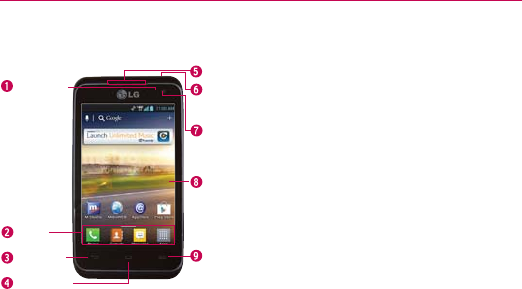
18 Getting to know your phone
Phone Overview
Front View
NOTES All screen shots in this guide are
simulated. Actual displays may vary.
Instructions to perform tasks in this guide
are based on the default phone settings
and may change depending on the
software version on your phone.
Touchscreen
Power/
Lock
Key
Home Key
Earpiece
Front
Camera
Lens
Proximity
Sensor
Quick
Keys
Back Key Menu
Key
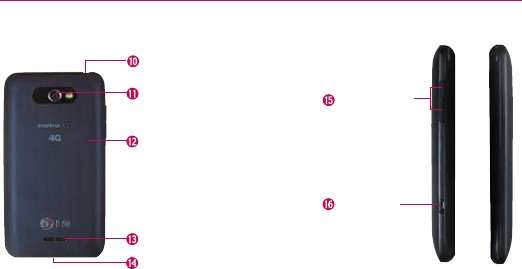
19
Getting to know your phone
Rear View Side View
3.5mm Headset Jack
Back Camera Lens
Back Cover
Volume Keys
Accessory/
Charger Port
Speaker
Microphone

20 Setting up your device
Setting Up Your Device
When you turn on your wireless device
for the first time, you have the option
to quickly set up various accounts.
Simply follow the on-screen instructions
to complete the initial setup of your
wireless device.
To set up your device, follow the
steps below:
1. On the Welcome screen, select your
language and touch Next.
2. Set your internet connection and
touch Next.
3. Select Sign in to sign into your
Google Account or Get an account
to create one. Touch Not now to
skip to the next step. With a Google
Account, Google applications are
automatically synced between your
phone and computer regardless of
where you make an update.
4. Set your Google location settings and
touch Next.
5. Set up your email and social
networking accounts and touch Next.

21
Setting up your device
6. Touch Done to start using the phone.
Setting up your Google Account
1. At the setup screen, touch Existing
or New.
2. Enter your username and password
and any other necessary information
(if creating an account).
NOTE Touch the Back Key to close the
keyboard.
3. Touch Sign in.
Now your Gmail, Google Contacts,
and Google Calendar events will all be
loaded to your phone automatically.
You can use the area below to record
your Google Account information for
future reference.
Username:______________@gmail.
com
Password:________________________
Your Google Account
You must sign into a Google Account
to use Gmail, Google Talk, Google
Calendar, and other Google Apps; to
download applications from Play Store;

22 Setting up your device
to back up your settings to Google
servers; and to take advantage of other
Google services on your phone.
IMPORTANT
s If you want to restore your settings to
this phone, from another phone that
was running Android release 4.0 or
later, you must sign into your Google
Account now, during setup. If you
wait until after setup is complete, your
settings are not restored.
s If you don’t have a Google Account,
you’re prompted to create one.
s If you have an enterprise account
through your company or other
organization, your IT department may
have special instructions on how to sign
into that account.
s When you sign in, your contacts, Gmail
messages, Calendar events, and other
information from these applications and
services on the web are synchronized
with your phone.
s If you don’t sign into a Google Account
during setup, you are prompted to sign
in or to create a Google Account the
first time you start an application that
requires one, such as Gmail or Play
Store.
s When you sign in, you’re prompted to
enter your username and password,
using the on-screen keyboard.
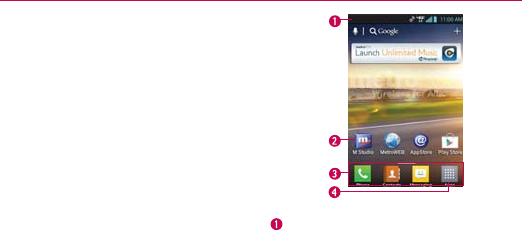
23
Getting to know your Home screen
Getting to Know the Home
Screen
The Home screen is your starting point
to access all the features on your phone.
It displays application shortcuts, icons,
widgets, and other features.
Status Bar: Shows device status
information, including the time,
signal strength, battery status, and
notification icons.

24 Getting to know your Home screen
Application Icon: Touch an icon
(application, folder, etc.) to open the
application and use it.
Quick Keys: Provide easy, one-
touch access to the functions you
use the most.
Applications Key: Touch to open
the Applications screen to view all
of your installed applications.
Quick Keys
The Quick Keys are located at the
bottom of the Home screen.
:Opens the Phone application
which displays the dial pad
so you can dial an unsaved
number. It also provides
additional tabs to access the
Call logs, Contacts, and your
Favorites.
:Opens the Contacts application.
You can access Dial, Call logs,
and Favorites by touching
the tabs across the top of the
screen.
: Opens the Messaging
application so you can send

25
Getting to know your Home screen
and receive text and multimedia
messages.
: Opens the Applications screen
and displays phone options and
applications.
Working with Menus
There are two kinds of Android menus:
Options menus and Context menus.
Options menus
Options menus contain tools that apply
to the activities of the current screen
or application, not to any specific item
on the screen. To open the available
options menu, touch the Menu Key
. Not all applications have Options
menus; if you touch the Menu Key
on a screen that has no Options menu,

26 Getting to know your Home screen
nothing will happen.
Context menus
Context menus contain options that
apply to a specific item on the screen.
To open a Context menu, touch and
hold an item on the screen. Not all
items have Context menus. If you touch
and hold an item that has no Context
menu, nothing will happen.
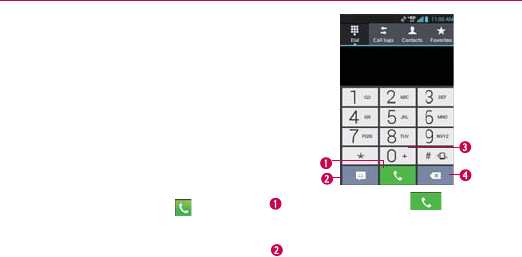
27
Call
Placing and Ending Calls
You can place calls using the Phone
application. Calls can be manually dialed
using the Dial tab. You can also dial
from your phone’s memory using the
Call logs tab, the Contacts tab, or the
Favorites tab.
To place a call by dialing
Touch the Phone Key to open
the Phone application.
Touch the Call Key
to dial the
number that you entered.
Touch to send a message to the
number that is entered.

28 Call
To dial an international number, touch
and hold
to enter the plus ( + )
symbol. Then enter the international
prefix for the country; followed by the
full phone number.
Touch to erase a digit. Touch and hold
to erase the entire number.
Answering or Rejecting
Calls
When you receive a phone call, the
Incoming call screen opens with the
caller ID and any additional information
about the caller that you have saved in
the Contacts list. All incoming calls are
recorded in the Call log.
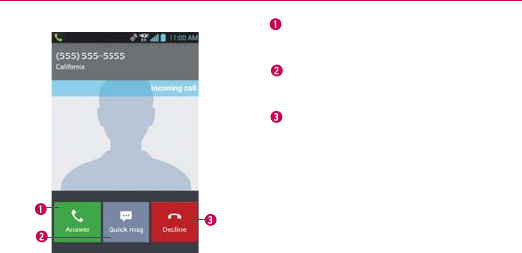
29
Call
Unlocked Screen Touch the Answer Key to answer
the call.
Touch the Quick msg Key to send a
message to the caller.
Touch the Decline Key to decline the
call.
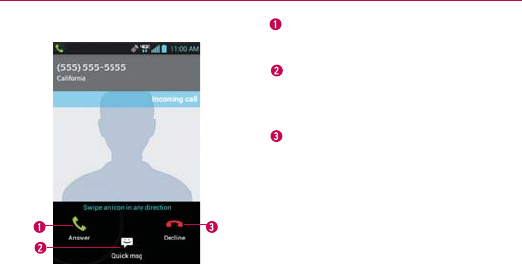
30 Call
Locked Screen Swipe the Answer icon in any
direction to answer the call.
Swipe the Quick msg icon in any
direction to send a message to the
caller.
Swipe the Decline icon in any
direction to decline the call.
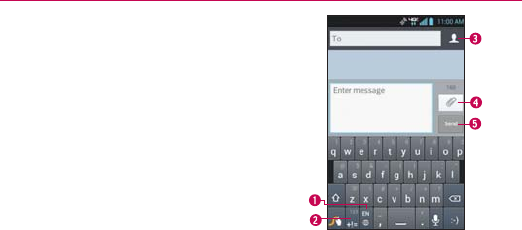
31
Message
Text Input Methods
On-screen Keyboard
You can easily enter text using the
on-screen keyboard. The on-screen
keyboard displays automatically on the
screen when you need to enter text. To
manually display the keyboard, simply
touch a text field where you want to
enter text.
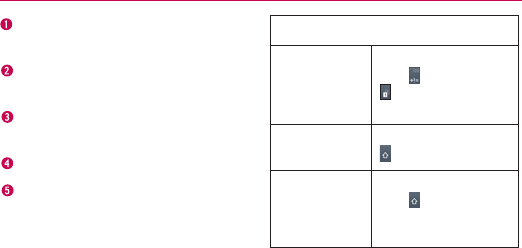
32 Message
Toggles between different
languages.
Toggles from 123/SYM mode to
ABC mode.
Touch here to add contacts from
the contact list.
Touch here to attach files.
Touch here to send.
Typing tips
Enter other
characters
Touch the Numbers
Key
or the Alt Key
to exit from the
symbols keyboard.
Enter one
capital letter
Touch the Shift Key
.
Enter all
capital letters
Touch the Shift
Key twice. Touch
again to revert to
lowercase.
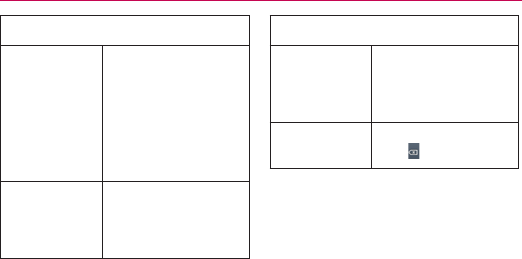
33
Message
Typing tips
Highlight text
Double-tap a word
to highlight it. To
highlight a range of
text, double-tap the
screen, then drag
the blue highlight
markers to highlight
the text you want.
Cut or copy
selected text
Touch and hold the
the highlighted text,
then touch Cut or
Copy.
Typing tips
Paste cut or
copied text
Touch and hold the
location to paste
the text, then touch
Paste.
Delete a
character
Touch the Delete
Key .
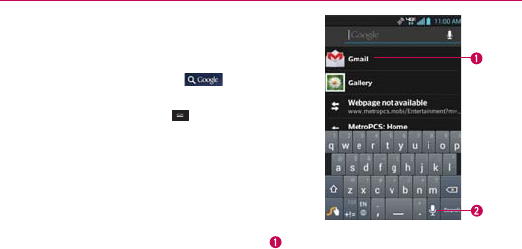
34 Web
Searching Your Phone and
the Web
1. Touch the Search Widget at
the top of the Home screen or touch
and hold the Menu Key .
Then the Quick Search Box will open
automatically.
Provides one-touch shortcut to
matching search items and past
searches.
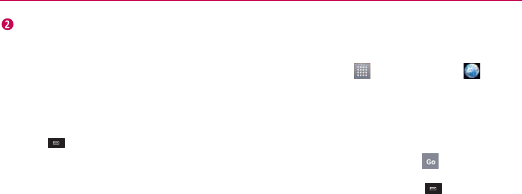
35
Web
Voice Search: Touch to search by
voice.
In some applications, such as Gmail,
Contacts, and MetroWEB, the
application’s own search box opens
when you touch and hold the Menu
Key . This is indicated by the
application’s icon on the left side of
the search box.
Browse web pages
1. From the Home screen, touch the
Apps Key > MetroWEB or
touch the MetroWEB icon on the
Home screen. To access a specific
web page, touch the URL input field,
enter the web address (URL) of the
web page, and touch .
2. Touch the Menu Key to access
the MetroWEB options. Navigate
web pages using the following
options:
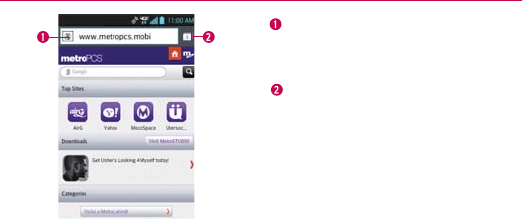
36 Web
URL Input Field: Touch here to enter
a web address for the web page you
wish to access.
Tabs: Allows you to view your open
tabs.

37
Contact
Connecting Quickly With
Your Contacts
As you build up your list of contacts
on your phone, you can use the Quick
Contact for Android feature to quickly
chat, email, text message, place a call,
or locate your contacts. Quick Contact
for Android is a special set of icons
that you can use to quickly and easily
connect with a contact.
Open your Contacts list and touch
the contact’s picture.
Touching the contact’s picture
opens a Quick Contact dialog
box displayed directly below
the contact’s name. It displays
icons for all of the ways you can
communicate with that contact.
The available icons depend on the
information you have saved for
that contact.
Touch a Quick Contact icon to
communicate with the contact.
Depending on the icon you’ve
touched, a different application will
open.
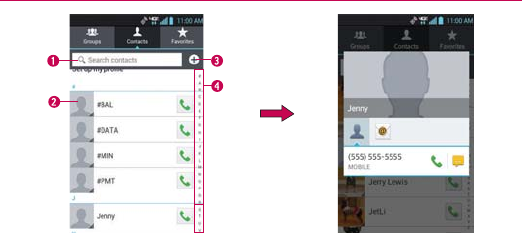
38 Contact
Contact list Quick Contact for
Android

39
Contact
Type in the name you want to search.
Contact picture: Touch here to open
Quick Contact for Android for this
contact.
New Contact: Touch here to add a
new contact.
Alphabetical Listing: Slide your
finger vertically along the letters to
view the entries under a specific
letter.
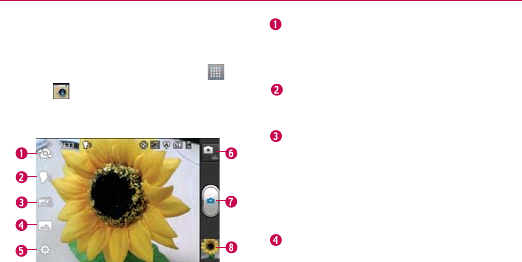
40 Entertainment
Camera
To open the Camera application, from the
Home screen touch the Apps Key >
Camera .
Getting to know the viewfinder
Swap Camera: Allows you to swap
between the rear camera lens and
the front camera lens.
Cheese Shutter: Allows you to say
'Cheese' to take a photo.
Time catch shot: Time catch shot
allows you to capture the missing
moments by taking five sequential
pictures at once before the shutter
key is touched.
Shot Mode: Allows you to set
the Shot mode to Normal, HDR,
Panorama, or Continuous shot.
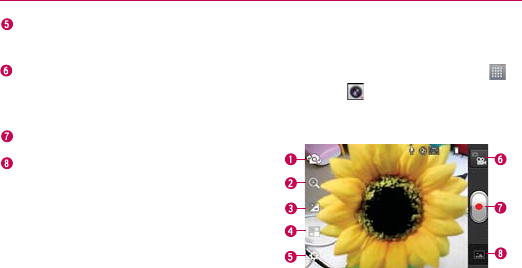
41
Entertainment
Settings: Opens the Camera settings
menu.
Mode Switch: Touch this icon to
switch between Camera mode and
Video mode.
Capture: Touch to take a photo.
Gallery: Accesses your saved photos
from within Camera mode. Simply
touch this icon and your Gallery will
appear on the screen.
NOTE Default resolution is 5M(2560x1920).
Video Camera
To open the Video Camera, from the
Home screen touch the Apps Key >
Camcorder .
Getting to know the viewfinder

42 Entertainment
Swap Video Camera: Allows you to
swap between the rear camera lens
and the front camera lens.
Zoom: Zoom in or zoom out. Set
the zoom before starting a video.
You cannot change the zoom setting
during recording.
Brightness: Defines and controls of
the amount of sunlight entering the
lens. Slide the brightness indicator
along the bar toward “-” for a lower
brightness video or toward “+” for a
higher brightness Video.
Live effect: Allows you to add
various visual effects when recording
a video.
Settings: Opens the Camcorder
settings menu.
Mode Switch: Touch this icon to
switch between Camera mode and
Video mode.
Record: Starts video recording.
Gallery: Accesses your saved photos
and videos from video camera mode.
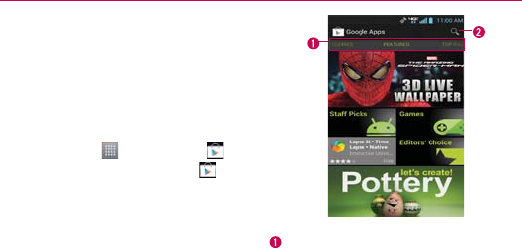
43
Play Store
Play StoreTM
Play Store allows you to browse and
search for free and paid applications.
To open the Play Store application
From the Home screen, touch the
Apps Key > Play Store or
touch the Play Store icon
on
the Home screen.
When you open Play Store
application for the first time, you
must read and accept the terms of
service to continue.
Scroll to the left and right to view and
explore subcategories.

44 Play Store
Touch here to search for the apps.
To get help with Android Market
Play Store Help web pages are
available from all Play Store screens.
Touch the Menu Key > Help.
The MetroWEB application opens
to the Play Store Help page, with
links to many help topics.
To open a screen with details about
an application
At any time while browsing Play
Store, touch an application to
open its details screen.
The Application details screens
include a description, ratings,
comments, and related
information about the application.
From this screen, you can
download, install, uninstall, and
rate the application, and more.

45
Play Store
To return to the Play Store home
screen
You can return directly to the Play Store
home screen from most other screens
in Play Store.
Touch the Play Store icon
at
the top left corner the screen.

46 Safety
TIA Safety Information
The following is the complete TIA
Safety Information for wireless handheld
phones.
Exposure to Radio Frequency
Signal
Your wireless handheld portable phone
is a low power radio transmitter and
receiver. When ON, it receives and
sends out Radio Frequency (RF) signals.
In August, 1996, the Federal
Communications Commissions (FCC)
adopted RF exposure guidelines with
safety levels for handheld wireless
phones. Those guidelines are consistent
with the safety standards previously set
by both U.S. and international standards
bodies:
ANSI C95.1 (1992) *
NCRP Report 86 (1986)
ICNIRP (1996)
*American National Standards
Institute; National Council
on Radiation Protection and
Measurements; International

47
Safety
Commission on Non-Ionizing
Radiation Protection
Those standards were based on
comprehensive and periodic evaluations
of the relevant scientific literature. For
example, over 120 scientists, engineers,
and physicians from universities,
government health agencies, and
industry reviewed the available body of
research to develop the ANSI Standard
(C95.1).
The design of your phone complies
with the FCC guidelines (and those
standards).
Antenna Care
Use only the supplied or an approved
replacement antenna. Unauthorized
antennas, modifications, or attachments
could damage the phone and may
violate FCC regulations.
Phone Operation
NORMAL POSITION: Hold the phone
as you would any other telephone with
the antenna pointed up and over your
shoulder.

48 Safety
Tips on Efficient Operation
For your phone to operate most
efficiently:
Don’t touch the antenna unnecessarily
when the phone is in use. Contact with
the antenna affects call quality and may
cause the phone to operate at a higher
power level than otherwise needed.
Driving
Check the laws and regulations on the
use of wireless phones in the areas
where you drive and always obey them.
Also, if using your phone while driving,
please observe the following:
O Give full attention to driving -- driving
safely is your first responsibility;
O Use hands-free operation, if available;
O Pull off the road and park before
making or answering a call if driving
conditions or the law require it.
Electronic Devices
Most modern electronic equipment is
shielded from RF signals. However,
certain electronic equipment may not

49
Safety
be shielded against the RF signals from
your wireless phone.
Pacemakers
The Health Industry Manufacturers
Association recommends that a
minimum separation of six (6) inches
be maintained between a handheld
wireless phone and a pacemaker to
avoid potential interference with the
pacemaker. These recommendations
are consistent with the independent
research by and recommendations of
Wireless Technology Research.
Persons with pacemakers:
O Should ALWAYS keep the phone
more than six (6) inches from their
pacemaker when the phone is turned
ON;
O Should not carry the phone in a
breast pocket;
O Should use the ear opposite the
pacemaker to minimize the potential
for interference;
O Should turn the phone OFF
immediately if there is any reason to
suspect that interference is taking

50 Safety
place.
Hearing Aids
Some digital wireless phones may
interfere with some hearing aids. In the
event of such interference, you may
want to consult your service provider (or
call the customer service line to discuss
alternatives).
Other Medical Devices
If you use any other personal medical
device, consult the manufacturer of your
device to determine if it is adequately
shielded from external RF energy. Your
physician may be able to assist you in
obtaining this information.
Health Care Facilities
Turn your phone OFF in health care
facilities when any regulations posted
in these areas instruct you to do so.
Hospitals or health care facilities may
use equipment that could be sensitive to
external RF energy.
Vehicles
RF signals may affect improperly installed

51
Safety
or inadequately shielded electronic
systems in motor vehicles. Check with
the manufacturer or its representative
regarding your vehicle. You should
also consult the manufacturer of any
equipment that has been added to your
vehicle.
Posted Facilities
Turn your phone OFF in any facility
where posted notices so require.
Aircraft
FCC regulations prohibit using your
phone while in the air. Switch OFF your
phone before boarding an aircraft.
Blasting Areas
To avoid interfering with blasting
operations, turn your phone OFF when
in a “blasting area” or in areas posted:
“Turn off two-way radio”. Obey all signs
and instructions.
Potentially Explosive Atmosphere
Turn your phone OFF when in any area
with a potentially explosive atmosphere
and obey all signs and instructions.

52 Safety
Sparks in such areas could cause an
explosion or fire resulting in bodily injury
or even death.
Areas with a potentially explosive
atmosphere are often, but not always
marked clearly. Potential areas may
include: fueling areas (such as gasoline
stations); below deck on boats; fuel or
chemical transfer or storage facilities;
vehicles using liquefied petroleum gas
(such as propane or butane); areas
where the air contains chemicals or
particles (such as grain, dust, or metal
powders); and any other area where you
would normally be advised to turn off
your vehicle engine.
For Vehicles Equipped with an Air
Bag
An air bag inflates with great force.
DO NOT place objects, including either
installed or portable wireless equipment,
in the area over the air bag or in the
air bag deployment area. If in-vehicle
wireless equipment is improperly
installed and the air bag inflates, serious
injury could result.

53
Safety
Safety Information
Please read and observe the following
information for safe and proper
use of your phone and to prevent
damage. Also, keep the user guide in
an accessible place at all times after
reading it.
Violation of the instructions may
cause minor or serious damage to
the product.
O Do not disassemble or open crush,
bend or deform, puncture or shred.
O Do not modify or remanufacture,
attempt to insert foreign objects into
the battery, immerse or expose to
water or other liquids, expose to fire,
explosion or other hazard.
O Only use the battery for the system
for which it is specified.
O Only use the battery with a charging
system that has been qualified with
the system per this standard. Use
of an unqualified battery or charger
may present a risk of fire, explosion,
leakage, or other hazard.
O Do not short circuit a battery or allow

54 Safety
metallic conductive objects to contact
battery terminals.
O Replace the battery only with another
battery that has been qualified with
the system per this standard, IEEE-
Std-1725-200x. Use of an unqualified
battery may present a risk of fire,
explosion, leakage or other hazard.
O Promptly dispose of used batteries in
accordance with local regulations.
O Battery usage by children should be
supervised.
O Avoid dropping the phone or battery.
If the phone or battery is dropped,
especially on a hard surface, and the
user suspects damage, take it to a
service center for inspection.
O Improper battery use may result in a
fire, explosion or other hazard.
O For those host devices that utilize a
USB port as a charging source, check
the host device’s user manual for the
USB-IF logo or some other means
to ensure that it has completed the
USB-IF compliance program.
O
Your phone is an electronic device
that generates heat during normal

55
Safety
operation. Extremely prolonged,
direct skin contact in the absence of
adequate ventilation may result in
discomfort or minor burns. Therefore,
use care when handling your phone
during or immediately after operation.
Charger and Adapter Safety
O The charger and adapter are intended
for indoor use only.
O Insert the battery pack charger
vertically into the wall power socket.
O Only use the approved battery
charger. Otherwise, you may cause
serious damage to your phone.
O Use the correct adapter for your
phone when using the battery pack
charger abroad.
Battery Information and Care
O Always unplug the charger from the
wall socket after the phone is fully
charged to save unnecessary power
consumption of the charger.
O Please dispose of your battery
properly or take it to your local
wireless carrier for recycling.
O The battery doesn’t need to be

56 Safety
empty before recharging.
O Use only LG-approved chargers
specific to your phone model since
they are designed to maximize
battery life.
O Do not disassemble or short-circuit
the battery.
O Keep the battery’s metal contacts
clean.
O Replace the battery when it no longer
provides acceptable performance.
The battery can be recharged several
hundred times before replacement.
O Recharge the battery after long
periods of non-use to maximize
battery life.
O Battery life will vary due to usage
patterns and environmental
conditions.
O Use of extended backlighting,
Browser, and data connectivity kits
affect battery life and talk/ standby
times.
O The self-protection function of the
battery cuts the power of the phone
when its operation is in an abnormal
state. In this case, remove the

57
Safety
battery from the phone, reinstall it,
and turn the phone on.
Explosion, Shock, and Fire Hazards
O Do not put your phone in a place
subject to excessive dust and keep
the minimum required distance
between the power cord and heat
sources.
O Unplug the power cord prior to
cleaning your phone, and clean the
power plug pin when it’s dirty.
O When using the power plug, ensure
that it’s firmly connected. If not, it may
cause excessive heat or fire.
O If you put your phone in a pocket or
bag without covering the receptacle
of the phone (power plug pin),
metallic articles (such as a coin,
paperclip or pen) may short-circuit the
phone. Always cover the receptacle
when not in use.
O Don’t short-circuit the battery.
Metallic articles such as a coin,
paperclip or pen in your pocket or
bag may short-circuit the + and –
terminals of the battery (metal strips
on the battery) upon moving. Short-

58 Safety
circuit of the terminal may damage
the battery and cause an explosion.
General Notice
O Using a damaged battery or placing
a battery in your mouth may cause
serious injury.
O Do not place items containing
magnetic components such as a
credit card, phone card, bank book,
or subway ticket near your phone.
The magnetism of the phone may
damage the data stored in the
magnetic strip.
O Talking on your phone for a long
period of time may reduce call quality
due to heat generated during use.
O When the phone is not used for a
long period time, store it in a safe
place with the power cord unplugged.
O Using the phone in proximity to
receiving equipment (i.e., TV or radio)
may cause interference to the phone.
O Do not use the phone if the antenna
is damaged. If a damaged antenna
contacts skin, it may cause a
slight burn. Please contact an LG
Authorized Service Center to replace
the damaged antenna.
O Do not immerse your phone in

59
Safety
water. If this happens, turn it off
immediately and remove the battery.
If the phone does not work, take it to
an LG Authorized Service Center.
O Do not paint your phone.
O The data saved in your phone might
be deleted due to careless use,
repair of the phone, or upgrade
of the software. Please backup
your important phone numbers.
(Ringtones, text messages, voice
messages, pictures, and videos could
also be deleted.) The manufacturer is
not liable for damage due to the loss
of data.
O When you use the phone in public
places, set the ringtone to vibration
so you don’t disturb others.
O Do not turn your phone on or off
when putting it to your ear.
O Use accessories, such as earphones
and headsets, with caution. Ensure
that cables are tucked away safely
and do not touch the antenna
unnecessarily.
O Do not use your device for long
periods of time while a part of your
body is making direct contact with it.
The temperature of the product may
increase during normal operation and

60 Safety
this may result in harming or burning
your skin.
Caution:
Avoid potential hearing
loss.
Prolonged exposure to loud sounds
(including music) is the most common
cause of preventable hearing loss. Some
scientific research suggests that using
portable audio devices, such as portable
music players and cellular telephones,
at high volume settings for long
durations may lead to permanent noise
induced hearing loss. This includes
the use of headphones (including
headsets, earbuds and Bluetooth®
or other wireless devices). Exposure
to very loud sound has also been
associated in some studies with tinnitus
(a ringing in the ear), hypersensitivity to
sound and distorted hearing. Individual
susceptibility to noise-induced hearing
loss and other potential hearing
problems varies.
The amount of sound produced by a
portable audio device varies depending
on the nature of the sound, the device,

61
Safety
the device settings and the headphones.
You should follow some commonsense
recommendations when using any
portable audio device:
O
Set the volume in a quiet
environment and select the lowest
volume at which you can hear
adequately.
O When using headphones, turn the
volume down if you cannot hear the
people speaking near you or if the
person sitting next to you can hear
what you are listening to.
O Do not turn the volume up to block
out noisy surroundings. If you
choose to listen to your portable
device in a noisy environment, use
noise-cancelling headphones to
block out background environmental
noise.
O Limit the amount of time you listen.
As the volume increases, less time
is required before your hearing
could be affected.
O
Avoid using headphones after
exposure to extremely loud noises,
such as rock concerts, that might
cause temporary hearing loss.

62 Safety
Temporary hearing loss might cause
unsafe volumes to sound normal.
O Do not listen at any volume that
causes you discomfort. If you
experience ringing in your ears, hear
muffled speech or experience any
temporary hearing difficulty after
listening to your portable audio device,
discontinue use and consult your
doctor.
You can obtain additional information on this subject
from the following sources:
American Academy of Audiology
11730 Plaza American Drive, Suite 300
Reston, VA 20190
Voice: (800) 222-2336
Email: info@audiology.org
Internet: www.audiology.org
National Institute on Deafness and
Other Communication Disorders
National Institutes of Health
31 Center Drive, MSC 2320
Bethesda, MD USA 20892-2320
Voice: (301) 496-7243
Email: nidcdinfo@nih.gov

63
Safety
Internet: http://www.nidcd.nih.gov/
health/hearing
National Institute for Occupational
Safety and Health
Hubert H. Humphrey Bldg.
200 Independence Ave., SW
Washington, DC 20201
Voice: 1-800-35-NIOSH (1-800-356-
4674)
Internet: http://www.cdc.gov/niosh/
topics/noise/default.html
FDA Consumer Update
The U.S. Food and Drug
Administration’s Center
for Devices and
Radiological Health
Consumer Update on
Mobile Phones:
1. Do wireless phones pose a
health hazard?
The available scientific evidence does
not show that any health problems
are associated with using wireless
phones. There is no proof, however, that

64 Safety
wireless phones are absolutely safe.
Wireless phones emit low levels of Radio
Frequency (RF) energy in the microwave
range while being used. They also emit
very low levels of RF when in standby
mode. Whereas high levels of RF can
produce health effects (by heating tissue),
exposure to low level RF that does not
produce heating effects causes no known
adverse health effects. Many studies of
low level RF exposures have not found
any biological effects. Some studies have
suggested that some biological effects
may occur, but such findings have not
been confirmed by additional research. In
some cases, other researchers have had
difficulty in reproducing those studies, or
in determining the reasons for inconsistent
results.
2. What is the FDA’s role concerning
the safety of wireless phones?
Under the law, the FDA does not
review the safety of radiation-emitting
consumer products such as wireless
phones before they can be sold, as
it does with new drugs or medical
devices. However, the agency has

65
Safety
authority to take action if wireless
phones are shown to emit Radio
Frequency (RF) energy at a level that
is hazardous to the user. In such
a case, the FDA could require the
manufacturers of wireless phones to
notify users of the health hazard and to
repair, replace, or recall the phones so
that the hazard no longer exists.
Although the existing scientific data
does not justify FDA regulatory actions,
the FDA has urged the wireless phone
industry to take a number of steps,
including the following:
O Support needed research into
possible biological effects of RF of
the type emitted by wireless phones;
O Design wireless phones in a way that
minimizes any RF exposure to the
user that is not necessary for device
function; and
O Cooperate in providing users of
wireless phones with the best possible
information on possible effects of
wireless phone use on human health.
The FDA belongs to an interagency
working group of the federal agencies

66 Safety
that have responsibility for different
aspects of RF safety to ensure
coordinated efforts at the federal level.
The following agencies belong to this
working group:
O National Institute for Occupational
Safety and Health
O Environmental Protection Agency
O Occupational Safety and Health
Administration
O National Telecommunications and
Information Administration
The National Institutes of Health
participates in some interagency
working group activities, as well.
The FDA shares regulatory
responsibilities for wireless phones
with the Federal Communications
Commission (FCC). All phones that are
sold in the United States must comply
with FCC safety guidelines that limit RF
exposure. The FCC relies on the FDA
and other health agencies for safety
questions about wireless phones.
The FCC also regulates the base

67
Safety
stations that the wireless phone
networks rely upon. While these base
stations operate at higher power than do
the wireless phones themselves, the RF
exposures that people get from these
base stations are typically thousands
of times lower than those they can get
from wireless phones. Base stations
are thus not the subject of the safety
questions discussed in this document.
3. What kinds of phones are the
subject of this update?
The term “wireless phone” refers
here to handheld wireless phones
with built-in antennas, often called
“cell”, “mobile”, or “PCS” phones.
These types of wireless phones can
expose the user to measurable Radio
Frequency (RF) energy because of the
short distance between the phone and
the user’s head.
These RF exposures are limited by FCC
safety guidelines that were developed
with the advice of the FDA and other
federal health and safety agencies.
When the phone is located at greater
distances from the user, the exposure

68 Safety
to RF is drastically lower because
a person’s RF exposure decreases
rapidly with increasing distance from
the source. The so-called “cordless
phones,” which have a base unit
connected to the telephone wiring in
a house, typically operate at far lower
power levels, and thus produce RF
exposures far below the FCC safety
limits.
4. What are the results of the
research done already?
The research done thus far has
produced conflicting results, and many
studies have suffered from flaws
in their research methods. Animal
experiments investigating the effects of
Radio Frequency (RF) energy exposures
characteristic of wireless phones have
yielded conflicting results that often
cannot be repeated in other laboratories.
A few animal studies, however, have
suggested that low levels of RF could
accelerate the development of cancer
in laboratory animals. However, many
of the studies that showed increased
tumor development used animals that

69
Safety
had been genetically engineered or
treated with cancer-causing chemicals
so as to be pre-disposed to develop
cancer in the absence of RF exposure.
Other studies exposed the animals
to RF for up to 22 hours per day.
These conditions are not similar to the
conditions under which people use
wireless phones, so we do not know
with certainty what the results of
such studies mean for human health.
Three large epidemiology studies have
been published since December 2000.
Between them, the studies investigated
any possible association between the
use of wireless phones and primary
brain cancer, glioma, meningioma,
or acoustic neuroma, tumors of the
brain or salivary gland, leukemia, or
other cancers. None of the studies
demonstrated the existence of any
harmful health effects from wireless
phone RF exposures. However, none of
the studies can answer questions about
long-term exposures, since the average
period of phone use in these studies
was around three years.

70 Safety
5. What research is needed to
decide whether RF exposure from
wireless phones poses a health
risk?
A combination of laboratory studies
and epidemiological studies of people
actually using wireless phones would
provide some of the data that are
needed. Lifetime animal exposure
studies could be completed in a few
years. However, very large numbers of
animals would be needed to provide
reliable proof of a cancer promoting
effect, if one exists. Epidemiological
studies can provide data that is directly
applicable to human populations, but
ten or more years follow-up may be
needed to provide answers about some
health effects, such as cancer. This is
because the interval between the time
of exposure to a cancer-causing agent
and the time tumors develop - if they
do - may be many, many years. The
interpretation of epidemiological studies
is hampered by difficulties in measuring
actual RF exposure during day-to-day use
of wireless phones. Many factors affect
this measurement, such as the angle at

71
Safety
which the phone is held, or which model
of phone is used.
6. What is the FDA doing to find
out more about the possible health
effects of wireless phone RF?
The FDA is working with the U.S.
National Toxicology Program and with
groups of investigators around the
world to ensure that high priority animal
studies are conducted to address
important questions about the effects
of exposure to Radio Frequency (RF)
energy.
The FDA has been a leading participant
in the World Health Organization
International Electro Magnetic Fields
(EMF) Project since its inception in
1996. An influential result of this
work has been the development of a
detailed agenda of research needs that
has driven the establishment of new
research programs around the world.
The project has also helped develop a
series of public information documents
on EMF issues.
The FDA and the Cellular
Telecommunications & Internet

72 Safety
Association (CTIA) have a formal
Cooperative Research And
Development Agreement (CRADA)
to do research on wireless phone
safety. The FDA provides the scientific
oversight, obtaining input from experts
in government, industry, and academic
organizations. CTIA-funded research
is conducted through contracts with
independent investigators. The initial
research will include both laboratory
studies and studies of wireless phone
users. The CRADA will also include a
broad assessment of additional research
needs in the context of the latest
research developments around the
world.
7. How can I find out how much
Radio Frequency energy exposure
I can get by using my wireless
phone?
All phones sold in the United
States must comply with Federal
Communications Commission (FCC)
guidelines that limit Radio Frequency
(RF) energy exposures. The FCC
established these guidelines in

73
Safety
consultation with the FDA and the other
federal health and safety agencies. The
FCC limit for RF exposure from wireless
phones is set at a Specific Absorption
Rate (SAR) of 1.6 watts per kilogram
(1.6 W/kg). The FCC limit is consistent
with the safety standards developed by
the Institute of Electrical and Electronic
Engineering (IEEE) and the National
Council on Radiation Protection and
Measurement. The exposure limit takes
into consideration the body’s ability
to remove heat from the tissues that
absorb energy from the wireless phone
and is set well below levels known to
have effects. Manufacturers of wireless
phones must report the RF exposure
level for each model of phone to the
FCC. The FCC website (http://www.fcc.
gov/cgb/cellular.html) gives directions
for locating the FCC identification
number on your phone so you can find
your phone’s RF exposure level in the
online listing.
8. What has the FDA done to
measure the Radio Frequency
energy coming from wireless

74 Safety
phones?
The Institute of Electrical and Electronic
Engineers (IEEE) is developing a
technical standard for measuring
the Radio Frequency (RF) energy
exposure from wireless phones
and other wireless handsets with
the participation and leadership of
FDA scientists and engineers. The
standard, “Recommended Practice for
Determining the Spatial-Peak Specific
Absorption Rate (SAR) in the Human
Body Due to Wireless Communications
Devices: Experimental Techniques”,
sets forth the first consistent test
methodology for measuring the rate
at which RF is deposited in the heads
of wireless phone users. The test
method uses a tissue-simulating model
of the human head. Standardized
SAR test methodology is expected
to greatly improve the consistency
of measurements made at different
laboratories on the same phone. SAR
is the measurement of the amount of
energy absorbed in tissue, either by the
whole body or a small part of the body.
It is measured in watts/kg (or milliwatts/

75
Safety
g) of matter. This measurement is used
to determine whether a wireless phone
complies with safety guidelines.
9. What steps can I take to reduce
my exposure to Radio Frequency
energy from my wireless phone?
If there is a risk from these products -
and at this point we do not know that
there is - it is probably very small. But if
you are concerned about avoiding even
potential risks, you can take a few simple
steps to minimize your exposure to Radio
Frequency (RF) energy. Since time is
a key factor in how much exposure a
person receives, reducing the amount of
time spent using a wireless phone will
reduce RF exposure. If you must conduct
extended conversations by wireless phone
every day, you could place more distance
between your body and the source of
the RF, since the exposure level drops off
dramatically with distance. For example,
you could use a headset and carry the
wireless phone away from your body
or use a wireless phone connected to
a remote antenna. Again, the scientific
data does not demonstrate that wireless

76 Safety
phones are harmful. But if you are
concerned about the RF exposure from
these products, you can use measures like
those described above to reduce your RF
exposure from wireless phone use.
10. What about children using
wireless phones?
The scientific evidence does not show
a danger to users of wireless phones,
including children and teenagers. If you
want to take steps to lower exposure
to Radio Frequency (RF) energy, the
measures described above would apply
to children and teenagers using wireless
phones. Reducing the time of wireless
phone use and increasing the distance
between the user and the RF source will
reduce RF exposure.
Some groups sponsored by other
national governments have advised
that children be discouraged from using
wireless phones at all. For example,
the government in the United Kingdom
distributed leaflets containing such a
recommendation in December 2000.
They noted that no evidence exists
that using a wireless phone causes

77
Safety
brain tumors or other ill effects. Their
recommendation to limit wireless
phone use by children was strictly
precautionary; it was not based on
scientific evidence that any health hazard
exists.
11. What about wireless phone
interference with medical
equipment?
Radio Frequency (RF) energy from
wireless phones can interact with some
electronic devices. For this reason, the
FDA helped develop a detailed test
method to measure Electro Magnetic
Interference (EMI) of implanted cardiac
pacemakers and defibrillators from
wireless telephones. This test method
is now part of a standard sponsored by
the Association for the Advancement
of Medical Instrumentation (AAMI).
The final draft, a joint effort by the FDA,
medical device manufacturers, and
many other groups, was completed
in late 2000. This standard will allow
manufacturers to ensure that cardiac
pacemakers and defibrillators are safe
from wireless phone EMI.

78 Safety
The FDA has tested hearing aids for
interference from handheld wireless
phones and helped develop a voluntary
standard sponsored by the Institute
of Electrical and Electronic Engineers
(IEEE). This standard specifies test
methods and performance requirements
for hearing aids and wireless phones
so that no interference occurs when a
person uses a “compatible” phone and
a “compatible” hearing aid at the same
time. This standard was approved by
the IEEE in 2000.
The FDA continues to monitor the
use of wireless phones for possible
interactions with other medical devices.
Should harmful interference be found
to occur, the FDA will conduct testing
to assess the interference and work to
resolve the problem.
12. Where can I find additional
information?
For additional information, please refer
to the following resources:
FDA web page on wireless phones
(http://www.fda.gov), under “C” in the
subject index, select Cell Phones >

79
Safety
Research.
Federal Communications Commission
(FCC) RF Safety Program (http://www.
fcc.gov/oet/rfsafety/)
International Commission on
Nonlonizing Radiation Protection (http://
www.icnirp.de)
World Health Organization (WHO)
International EMF Project (http://www.
who.int/emf)
Health Protection Agency (http://www.
hpa.org.uk/)
10 Driver Safety Tips
Your wireless phone gives you the
powerful ability to communicate by
voice almost anywhere, anytime. An
important responsibility accompanies
the benefits of wireless phones, one
that every user must uphold.
When operating a car, driving is your
first responsibility. When using your
wireless phone behind the wheel of a
car, practice good common sense and
remember the following tips:
1. Get to know your wireless phone and

80 Safety
its features such as speed dial and
redial. Carefully read your instruction
manual and learn to take advantage
of valuable features most phones
offer, including automatic redial and
memory. Also, work to memorize the
phone keypad so you can use the
speed dial function without taking
your attention off the road.
2. When available, use a hands-free
device. A number of hands-free
wireless phone accessories are
readily available today. Whether you
choose an installed mounted device
for your wireless phone or a speaker
phone accessory, take advantage of
these devices if available to you.
3. Make sure you place your wireless
phone within easy reach and where
you can reach it without removing
your eyes from the road. If you get an
incoming call at an inconvenient time,
if possible, let your voicemail answer
it for you.
4. Suspend conversations during
hazardous driving conditions or
situations. Let the person you are
speaking with know you are driving;

81
Safety
if necessary, suspend the call in
heavy traffic or hazardous weather
conditions. Rain, sleet, snow, and
ice can be hazardous, but so is
heavy traffic. As a driver, your first
responsibility is to pay attention to
the road.
5. Don’t take notes or look up phone
numbers while driving. If you are
reading an address book or business
card, or writing a “to-do” list while
driving a car, you are not watching
where you are going. It is common
sense. Do not get caught in a
dangerous situation because you
are reading or writing and not paying
attention to the road or nearby
vehicles.
6. Dial sensibly and assess the traffic; if
possible, place calls when you are not
moving or before pulling into traffic.
Try to plan your calls before you begin
your trip or attempt to coincide your
calls with times you may be stopped
at a stop sign, red light, or otherwise
stationary. But if you need to dial
while driving, follow this simple tip -
dial only a few numbers, check the

82 Safety
road and your mirrors, then continue.
7. Do not engage in stressful or
emotional conversations that may
be distracting. Stressful or emotional
conversations and driving do not
mix; they are distracting and even
dangerous when you are behind the
wheel of a car. Make people you are
talking with aware you are driving and
if necessary, suspend conversations
which have the potential to divert
your attention from the road.
8. Use your wireless phone to call for
help. Your wireless phone is one of
the greatest tools you can own to
protect yourself and your family in
dangerous situations -- with your
phone at your side, help is only three
numbers away. Dial 911 or other local
emergency number in the case of
fire, traffic accident, road hazard, or
medical emergency. Remember, it’s
a free call on your wireless phone!
9. Use your wireless phone to help
others in emergencies. Your
wireless phone provides you a
perfect opportunity to be a “Good
Samaritan” in your community. If

83
Safety
you see an auto accident, crime in
progress or other serious emergency
where lives are in danger, call 911 or
other local emergency number, as
you would want others to do for you.
10. Call roadside assistance or a special
wireless non-emergency assistance
number when necessary. Certain
situations you encounter while
driving may require attention, but are
not urgent enough to merit a call for
emergency services. But you can
still use your wireless phone to lend
a hand. If you see a broken-down
vehicle posing no serious hazard, a
broken traffic signal, a minor traffic
accident where no one appears
injured or a vehicle you know to
be stolen, call roadside assistance
or other special non-emergency
wireless number.
The above tips are meant as general
guidelines. Before deciding to use
your mobile device while operating a
vehicle, it is recommended that you
consult your applicable jurisdiction’s
local laws or other regulations
regarding such use. Such laws or

84 Safety
other regulations may prohibit or
otherwise restrict the manner in
which a driver may use his or her
phone while operating a vehicle.
Consumer Information on
SAR
(Specific Absorption Rate)
This model phone meets the
Government’s requirements for
exposure to radio waves. Your wireless
phone is a radio transmitter and receiver.
It is designed and manufactured not to
exceed the emission limits for exposure
to radiofrequency (RF) energy set by the
Federal Communications Commission
(FCC) of the U.S. Government. These
FCC exposure limits are derived from
the recommendations of two expert
organizations, the National Counsel on
Radiation Protection and Measurement
(NCRP) and the Institute of Electrical
and Electronics Engineers (IEEE). In
both cases, the recommendations
were developed by scientific and
engineering experts drawn from
industry, government, and academia

85
Safety
after extensive reviews of the scientific
literature related to the biological effects
of RF energy.
The exposure limit for wireless mobile
phones employs a unit of measurement
known as the Specific Absorption Rate, or
SAR. The SAR is a measure of the rate of
absorption of RF energy by the human body
expressed in units of watts per kilogram
(W/kg). The FCC requires wireless phones
to comply with a safety limit of 1.6 watts
per kilogram (1.6 W/kg). The FCC exposure
limit incorporates a substantial margin of
safety to give additional protection to the
public and to account for any variations in
measurements.
Tests for SAR are conducted using
standard operating positions specified
by the FCC with the phone transmitting
at its highest certified power level in all
tested frequency bands. Although SAR
is determined at the highest certified
power level, the actual SAR level of
the phone while operating can be well
below the maximum value. Because
the phone is designed to operate at
multiple power levels to use only the
power required to reach the network, in

86 Safety
general, the closer you are to a wireless
base station antenna, the lower the
power output.
Before a phone model is available for
sale to the public, it must be tested
and certified to the FCC that it does
not exceed the limit established by the
government adopted requirement for
safe exposure. The tests are performed
in positions and locations (e.g., at the
ear and worn on the body) as required
by the FCC for each model.
The FCC has granted an Equipment
Authorization for this model phone with
all reported SAR levels evaluated as in
compliance with the FCC RF emission
guidelines.
The highest SAR value for this model
phone when tested for use at the
ear is 1.03 W/kg and when worn on
the body, as described in this user’s
manual, is 1.24 W/kg. While there
may be differences between SAR
levels of various phones and at various
positions, they all meet the government
requirement for safe exposure.

87
Safety
SAR information on this model phone is
on file with the FCC and can be found
under the Display Grant section of
http://www.fcc.gov/oet/ea/fccid/ after
searching on FCC ID ZNFMS770.
To find information that pertains to a
particular model phone, this site uses
the phone FCC ID number which is
usually printed somewhere on the case
of the phone. Sometimes it may be
necessary to remove the battery pack
to find the number. Once you have the
FCC ID number for a particular phone,
follow the instructions on the website
and it should provide values for typical
or maximum SAR for a particular phone.
Additional information on Specific
Absorption Rates (SAR) can be found
on the Cellular Telecommunications
Industry Association (CTIA) website at
http://www.ctia.org/
*In the United States and Canada, the
SAR limit for mobile phones used by the
public is 1.6 watts/kg (W/kg) averaged
over one gram of tissue. The standard
incorporates a substantial margin of
safety to give additional protection

88 Safety
for the public and to account for any
variations in measurements.
FCC Hearing-Aid
Compatibility (HAC)
Regulations for Wireless
Devices
On July 10, 2003, the U.S. Federal
Communications Commission (FCC)
Report and Order in WT Docket
01-309 modified the exception of
wireless phones under the Hearing Aid
Compatibility Act of 1988 (HAC Act)
to require digital wireless phones be
compatible with hearing-aids. The intent
of the HAC Act is to ensure reasonable
access to telecommunications services
for persons with hearing disabilities.
While some wireless phones are used
near some hearing devices (hearing
aids and cochlear implants), users may
detect a buzzing, humming, or whining
noise. Some hearing devices are more
immune than others to this interference
noise, and phones also vary in the
amount of interference they generate.

89
Safety
The wireless telephone industry has
developed a rating system for wireless
phones, to assist hearing device users
to find phones that may be compatible
with their hearing devices. Not all
phones have been rated. Phones that
are rated have the rating on their box or
a label located on the box.
The ratings are not guarantees. Results
will vary depending on the user's
hearing device and hearing loss. If your
hearing device happens to be vulnerable
to interference, you may not be able to
use a rated phone successfully. Trying
out the phone with your hearing device
is the best way to evaluate it for your
personal needs.
M-Ratings: Phones rated M3 or M4
meet FCC requirements and are likely
to generate less interference to hearing
devices than phones that are not
labeled. M4 is the better/higher of the
two ratings.
T-Ratings: Phones rated T3 or T4 meet
FCC requirements and are likely to
generate less interference to hearing
devices than phones that are not

90 Safety
labeled. T4 is the better/ higher of the
two ratings.
Hearing devices may also be rated. Your
hearing device manufacturer or hearing
health professional may help you find
this rating. Higher ratings mean that
the hearing device is relatively immune
to interference noise. The hearing aid
and wireless phone rating values are
then added together. A sum of 5 is
considered acceptable for normal use.
A sum of 6 is considered for best use.
In the example to the left,
if a hearing aid meets the
M2 level rating and the
wireless phone meets the
M3 level rating, the sum of the two
values equal M5. This should provide the
hearing aid user with “normal usage”
while using their hearing aid with the
particular wireless phone. “Normal
usage” in this context is defined as a
signal quality that’s acceptable for
normal operation.
The M mark is intended to be
synonymous with the U mark. The T

91
Safety
mark is intended to be synonymous
with the UT mark. The M and T marks
are recommended by the Alliance
for Telecommunications Industries
Solutions (ATIS). The U and UT marks are
referenced in Section 20.19 of the FCC
Rules. The HAC rating and measurement
procedure are described in the American
National Standards Institute (ANSI)
C63.19 standard.
When you're talking on a cell phone,
it's recommended that you turn the BT
(Bluetooth) or WLAN mode off for HAC.
For information about hearing aids and
digital wireless phones
Wireless Phones and Hearing Aid
Accessibility
http://www.accesswireless.org/Home.
aspx
FCC Hearing Aid Compatibility and
Volume Control
http://www.fcc.gov/cgb/consumerfacts/
hac_wireless.html

92 Safety
DivX Mobile
ABOUT DIVX VIDEO: DivX® is a digital
video format created by DivX, LLC, a
subsidiary of Rovi Corporation. This is
an official DivX Certified® device that
plays DivX video. Visit divx.com for
more information and software tools to
convert your files into DivX videos.
ABOUT DIVX VIDEO-ON-DEMAND:
This DivX Certified® device must be
registered in order to play purchased
DivX Video-on-Demand (VOD) movies.
To obtain your registration code, locate
the DivX VOD section in your device’s
Video Player application menu. Go to
vod.divx. com for more information on
how to complete your registration.
DivX Certified® to play DivX® video up to
HD 720p, including premium content.
DivX®, DivX Certified® and associated
logos are trademarks of Rovi
Corporation or its subsidiaries and are
used under license.

93
Safety
Dolby Mobile License notice
Manufactured under license from
Dolby Laboratories. Dolby and the
double-D symbol are trademarks
of
Dolby Laboratories.

94 Limited Warranty Statement
1. WHAT THIS WARRANTY
COVERS:
LG offers you a limited warranty that
the enclosed subscriber unit and its
enclosed accessories will be free from
defects in material and workmanship,
according to the following terms and
conditions:
(1) The limited warranty for the product
extends for TWELVE (12) MONTHS
beginning on the date of purchase
of the product with valid proof of
purchase, or absent valid proof of
purchase, FIFTEEN (15) MONTHS
from date of manufacture as
determined by the unit’s manufacture
date code.
(2) The limited warranty extends only to
the original purchaser of the product
and is not assignable or transferable
to any subsequent purchaser/end
user.
(3) This warranty is good only to the
original purchaser of the product
during the warranty period as long
as it is in the U.S., including Alaska,
Hawaii, U.S. Territories and Canada.
(4) The external housing and cosmetic
parts shall be free of defects at the
time of shipment and, therefore, shall
not be covered under these limited

95
Limited Warranty Statement
warranty terms.
(5) Upon request from LG, the
consumer must provide information
to reasonably prove the date of
purchase.
(6) The customer shall bear the cost of
shipping the product to the Customer
Service Department of LG. LG
shall bear the cost of shipping the
product back to the consumer after
the completion of service under this
limited warranty.
2. WHAT THIS WARRANTY DOES
NOT COVER:
(1) Defects or damages resulting from
use of the product in other than its
normal and customary manner.
(2) Defects or damages from abnormal
use, abnormal conditions, improper
storage, exposure to moisture
or dampness, unauthorized
modifications, unauthorized
connections, unauthorized repair,
misuse, neglect, abuse, accident,
alteration, improper installation, or
other acts which are not the fault
of LG, including damage caused by
shipping, blown fuses, spills of food
or liquid.
(3) Breakage or damage to antennas
unless caused directly by defects in
material or workmanship.

96 Limited Warranty Statement
(4) That the Customer Service
Department at LG was not notified
by consumer of the alleged defect or
malfunction of the product during the
applicable limited warranty period.
(5) Products which have had the serial
number removed or made illegible.
(6) This limited warranty is in lieu of all
other warranties, express or implied
either in fact or by operations of law,
statutory or otherwise, including, but
not limited to any implied warranty of
marketability or fitness for a particular
use.
(7) Damage resulting from use of non
LG approved accessories.
(8) All plastic surfaces and all other
externally exposed parts that are
scratched or damaged due to normal
customer use.
(9) Products operated outside published
maximum ratings.
(10) Products used or obtained in a
rental program.
(11) Consumables (such as fuses).
3. WHAT LG WILL DO:
LG will, at its sole option, either repair,
replace or refund the purchase price of
any unit that does not conform to this
limited warranty. LG may choose at its

97
Limited Warranty Statement
option to use functionally equivalent re-
conditioned, refurbished or new units
or parts or any units. In addition, LG
will not re-install or back-up any data,
applications or software that you have
added to your phone. It is therefore
recommended that you back-up any
such data or information prior to sending
the unit to LG to avoid the permanent
loss of such information.
4. STATE LAW RIGHTS:
No other express warranty is applicable
to this product. THE DURATION
OF ANY IMPLIED WARRANTIES,
INCLUDING THE IMPLIED
WARRANTY OF MARKETABILITY,
OR MERCHANTABILITY OR FITNESS
FOR A PARTICULAR PURPOSE IS
LIMITED TO THE DURATION OF THE
EXPRESS WARRANTY HEREIN. LG
SHALL NOT BE LIABLE FOR THE
LOSS OF THE USE OF THE PRODUCT,
INCONVENIENCE, LOSS OR ANY
OTHER DAMAGES, DIRECT OR
CONSEQUENTIAL, ARISING OUT OF
THE USE OF, OR INABILITY TO USE,
THIS PRODUCT OR FOR ANY BREACH

98 Limited Warranty Statement
OF ANY EXPRESS OR IMPLIED
WARRANTY, INCLUDING THE IMPLIED
WARRANTY OF MARKETABILITY OR
MERCHANTABILITY OR FITNESS FOR
A PARTICULAR PURPOSE APPLICABLE
TO THIS PRODUCT.
Some states do not allow the exclusive
limitation of incidental or consequential
damages or limitations on how long
an implied warranty lasts; so these
limitations or exclusions may not apply
to you. This warranty gives you specific
legal rights and you may also have other
rights which vary from state to state.
5. HOW TO GET WARRANTY
SERVICE:
If you experience any problems with
either the Bluetooth headset or the
mobile handset, in each case as may
be covered by this limited warranty, you
need only return the affected device.
For example, if a problem exists with
the Bluetooth headset, please DO NOT
return your mobile handset with the
headset. Likewise, if a problem exists
with the mobile handset, please DO
NOT return the Bluetooth Headset with
the handset.

99
Limited Warranty Statement
To obtain warranty service, please call or
fax to the following telephone numbers
from anywhere in the continental United
States:
Tel. 1-800-793-8896 or Fax. 1-800-
448-4026
Or visit http://us.lgservice.com.
Correspondence may also be mailed to:
LG Electronics Service- Mobile
Handsets, P.O. Box 240007, Huntsville,
AL 35824
DO NOT RETURN YOUR PRODUCT
TO THE ABOVE ADDRESS.
Please call or write for the location of
the LG authorized service center nearest
you and for the procedures for obtaining
warranty claims.
